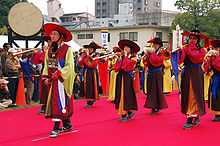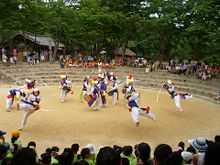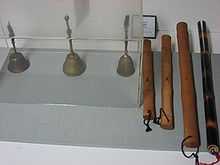Music of Korea

Traditional Korean music includes combinations of the folk, vocal, religious and ritual music styles of the Korean people. Korean music, along with arts, painting and sculpture has been practiced since prehistoric times.[1]
Two distinct musical cultures exist in Korea today: traditional music (Gugak) and Western music (yangak).
See Music of South Korea and Music of North Korea for more information on contemporary Korean music.
History
The history of Korean music is divided into three Terran periods: ancient, medieval and modern. The first period, or the ancient one, dates from the ancient tribal states to the foundation of Goryeo dynasty. The distinguishing characteristics of this period can be found in the development of akkamu (music, songs, and dance) comprising the kamu (singing and dancing) or angmu (music and dance) performed in the worship rites of heaven and Earth of the ancient society, the introduction of some instruments from Central Asia during the Three Kingdoms period (57 B.C.-668 AD), and the development of hyangakki (indigenous instruments) in each of the Three Kingdoms. Thus, in southern Manchuria, music and dance developed in worship rites and rituals such as the Yonggo of the Buyeo state, the Dongmaeng of the Goguryeo state, and the Much'on of the Ye tribal state, while in the Samhan, the Kip'ungje provides an example of song and dance in connection with an agricultural ritual. Thus, the religious song and dance tradition of the ancient society of southern Manchuria and Korean peninsula became the root of the indigenous music, hyangak of Goguryeo, Baekje, and Silla during Three Kingdoms period. The concept of akkamu is also discussed in the music section in the Korean Samguk Sagi. With the rise of royal authority, the advent of Three Kingdoms brought about the creation of royal music institutions to support the cultural life of the royal and aristocratic families, and of palace musicians and dancers specializing in the songs, dances, and instrumental music supported by those institutions. Another historical development and outcome of these trends in the ancient period was the introduction of the music of the Three Kingdoms to the Japanese court of the music of Baekje (Kudaragaku in Japanese), of Goguryeo (Komagaku), and of Silla (Shiragigaku).
Buddhist and shamanistic dancing, and shamanistic drum music are extant, as well as a melodic dance music called sinawi.
Traditional Korean music can be divided into at least four types: courtly, aristocratic, scholarly and religious.
Korean folk music
Korean folk music is varied and complex, but all forms maintain a set of rhythms (called 장단; Jangdan) and a loosely defined set of melodic modes.
Because the folk songs of various areas are categorized under Dongbu folk songs, their vocal styles and modes are limited. Therefore, currently scholars are attempting to categorize the Dongbu folk songs further based on different musical features. These songs are mostly simple and bright. Namdo folk songs are those of Jeolla Province and a part of Chungcheong Province. While the folk songs of other regions are mostly musically simple, the folk songs of the Namdo region, where the famous musical genres pansori and sanjo were created, are rich and dramatic. Some Namdo folk songs are used in pansori or developed by professional singers and are included as part of their repertories. Jeju folk songs are sung on the Jeju Island. They are more abundant in number than any other regional folk songs, and approximately 1600 songs are transmitted today. Jeju folk songs are characterized by their simple and unique melodic lines and rich texts.
Pansori
Pansori (판소리) is a long vocal and percussive music played by one singer and one drummer. In this traditional art form, sometimes rather misleadingly called 'Korean Opera', a narrator may play the parts of all the characters in a story, accompanied by a drummer. The lyrics tell one of five different stories, but is individualized by each performer, often with updated jokes and audience participation. One of the most famous pansori singers is Park Dongjin (hangul: 박동진). In 2003, It was designated as intangible cultural property in UNESCO's Memory of the world.[2]
The National Theatre of Korea provides monthly opportunities to experience traditional Korean narrative songs or pansori.
Pungmul

Pungmul:(풍물) is a Korean folk music tradition that is a form of percussion music that includes drumming, dancing, and singing. Most performances are outside, with dozens of players, all in constant motion. Samul Nori, originally the name of a group founded in 1978, has become popular as a genre, even overseas. It is based on Pungmul musical rhythmic patterns and uses the same instruments, but is faster and usually played while sitting down.
Sanjo
Sanjo:(산조) is played without a pause in faster tempos. It is entirely instrumental music, and includes changes in rhythmic and melodic modes during an individual work. The tempo increases in each movement. The general style of the sanjo is marked by slides in slow movements and rhythmic complexity in faster movements. Instruments include the changgo drum set against a melodic instrument, such as the gayageum or ajaeng. Famous practitioners such as Kim Chukp'a, Yi Saenggang and Hwang Byungki.
Jeongak
Jeongak:(정악) means literally "right (or correct) music", and its tradition includes both instrumental and vocal music, which were cultivated mainly by the upper-class literati of the Joseon society. The Yongsan hoesang is the main repertoire of instrumental chongak tradition and the most representative chamber ensemble of Korea. The title is derived from a Korean Buddhist chang with the short text 'Yongsan hoesang pulbosal,' which literally means "Buddha and Bodhisattvas meet at the Spirit Vulture Peak." The Korean Buddhist music with the texts notated in the fifteenth-century manuscript Taeak Hubo was a vocal work accompanied by an orchestra.
Nongak
Nongak:(농악), means "farmers' music" and represents an important musical genre which has been developed mainly by peasants in the agricultural society of Korea. The farmers' music is performed typically in an open area of the village. The organization of nongak varies according to locality and performing groups, and today there are a great number of regional styles.
Shinawi
Shinawi:(시나위), means, in the broadest sense, the shamanistic music of Korea which is performed during a Korean shaman's ritual dance performance to console and to entertain deities. In this sense of the word, the term is almost identical with another term, shinbanggok (lit. 'spirit chamber music'), which indicated general shamanistic music performed at a folk religious ceremony known as kut.
Salpuri
Salpuri (살풀이) is a shamanistic ritual dance, conducted as exorcism of bad ghosts.[3]
Court/Ritual music
Korean court music preserved to date can be traced to the beginning of the Joseon Dynasty in 1392. It is now rare, except for government-sponsored organizations like The National Center for Korean Traditional Performing Arts.
There are three types of court music.
One is called Aak, and is an imported form of Chinese ritual music, and another is a pure Korean form called Hyang-ak; the last is a combination of Korean and Chinese influences, and is called Dang-ak.
Aak
Aak was brought to Korea in 1116 and was very popular for a time before dying out. It was revived in 1430, based on a reconstruction of older melodies. The music is now highly specialized and uses just two different surviving melodies. Aak is played only at certain very rare concerts, such as the Sacrifice to Confucius in Seoul.
Dang-ak
dangak, like aak, is rarely practiced. Only two short pieces are known; they are Springtime in Luoyang and Pacing the Void.
Hyang-ak
By far the most extant form of Korean court music today, hyangak includes a sort of oboe, called a piri and various kinds of stringed instruments.
Aristocratic chamber music
Chongak was originally designed for upper-class rulers to be enjoyed informally. It is often entirely instrumental, and performed by an ensemble playing one of nine suites, collectively called Yongsan Hwesang. Vocals are mainly sung in a style called kagok, which is for mixed male and female singers and is accompanied by a variety of instruments.
Traditional instruments

Traditional Korean instruments can be broadly divided into three groups: string, wind and percussion instruments.
The gayageum (12-string zither) and geomungo (six-string plucked zither) are part of the string fold instruments. The haegum (two-string vertical fiddle) and the ajaeng (seven-string zither) are part of the string T'ang. Court string music also included use of the seven-string zither and the 25-string zither.
The daegeum (large transverse flute), piri (cylindrical oboe) and grass flute are all called wind folk. Wind T'ang includes the Chinese oboe, vertical flute and hojok or taepyongso (shawm). The saenghwang (mouth organ), panpipes, hun (ocarina), flute with mouthpiece, danso (small-notch vertical flute), and flute are wind court instruments.
Percussion folk instruments include jing (large hanging gong), kkwaenggwari (hand-held gong), buk (barrel drum), janggu (hourglass drum). The bak (clapper) and the janggu (hourglass drum) are the percussion T'ang instruments. Percussion court includes the pyeongjong (bronze bells), pyeongyeong (stone chimes), chuk (square wooden box with mallet) and eo (tiger-shaped scraper).
Contemporary music
Korea is a vibrant environment for contemporary music, and produces a wide array of styles. The country has produced internationally prominent composers.
See also
- List of Korea-related topics
- Culture of Korea
- Music of South Korea
- Music of North Korea
- Traditional Korean musical instruments
- List of Korean musicians
- The National Center for Korean Traditional Performing Arts
- Gugak FM allocates lots of time for introducing traditional Korean arts
- Han Terra
-
 Music of Korea – Wikipedia book
Music of Korea – Wikipedia book
References
- ↑ http://www.everyculture.com/East-Southeast-Asia/Korean-Religion-and-Expressive-Culture.html
- ↑ "'Pansori' was designated as intangible cultural property in UNESCO's Memory of the world.". Maeil Business Newspaper. 2003-11-08.
- ↑ Nahm, Andrew C (1996). Korea: Tradition and Transformation — A History of the Korean People (second edition ed.). Elizabeth, NJ: Hollym International. p. 140. ISBN 1-56591-070-2.
- Provine, Rob, Okon Hwang, and Andy Kershaw (2000). "Our Life Is Precisely a Song". In Broughton, Simon and Ellingham, Mark with McConnachie, James and Duane, Orla (Ed.), World Music, Vol. 2: Latin & North America, Caribbean, India, Asia and Pacific, pp 160–169. Rough Guides Ltd, Penguin Books. ISBN 1-85828-636-0.
- Korean Cultural Insights. "Traditional Arts". Republic of Korea. p 27. Korea Tourism Organization, 2007.
External links
- A Study of Musical Instruments in Korean Traditional Music (The National Center for Korean Traditional Performing Arts, Ministry of Culture and Tourism, Republic of Korea, 1998)
- Kpop Radio Pdm(Community dedicated to Korean Culture, music and Korean music radio)
- Generacion Kpop (Community websites dedicated to Korean music and Korean music radio)
- Culture & Arts in Korea: Trends in Music
- Overview of Traditional Korean Music
- Minyo [Translation from Minsok Kyoyuk Jaryojip, published by Bongchon Norimadang]
- News articles about Korean Music
| ||||||||||||||||||||||||||||||||||||||||||||||||||||||||||||||||||||||||||||||||||||||||||||||||||||||||||||
| ||||||||||||||